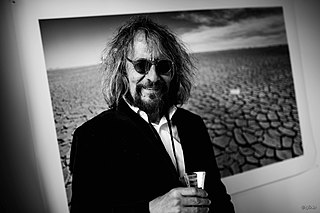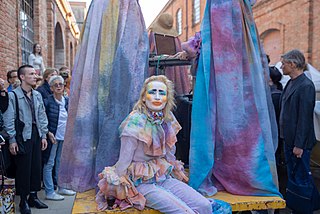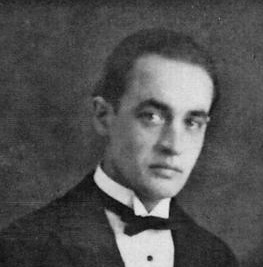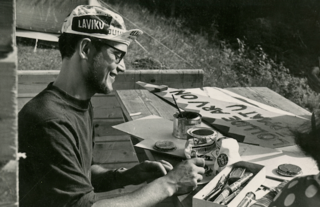Related Research Articles

The São Paulo Art Biennial was founded in 1951 and has been held every two years since. It is the second oldest art biennial in the world after the Venice Biennale, which serves as its role model.

The Kumu Art Museum is an art museum in Tallinn, Estonia. It is one of the largest museums in Estonia and one of the largest art museums in Northern Europe. It is one of the five branches of the Art Museum of Estonia, housing its main offices.
Erich Carl Hugo Adamson was an Estonian artist who worked mainly within the medium of painting in applied art.

Leonhard Lapin, also known under the pseudonym Albert Trapeež, was an Estonian architect, artist, architecture historian, and poet.

Gastón Ugalde Bolivian artist recipient of the Konex Award in 2002 along with Oscar Niemeyer is called "the most important living Bolivian artist" by the Konex Foundation in Argentina and is also referred as the "Andean Warhol" by art critics. Ugalde is also known as "the enfant terrible" of the Bolivian Art Scene.

Mall Nukke is an Estonian artist. A printmaker by training, she is primarily known for her paintings, collages and installations influenced by pop art. Mall Nukke emerged on the Estonian art scene in the early 1990s, her work at the period can be seen as commentary of nascent mass culture and consumer society in newly independent Estonia. Her early collages combined various cultural references and created new media characters based on real entertainers and public figures. Since the 2000s, Mall Nukke has concentrated on creating photo-manipulations and mixed media paintings inspired by Eastern Orthodox icon art.

Taavi Varm is an Estonian artist.

Liis Koger is an Estonian painter and poet based in Tallinn.

Timo Toots is an Estonian artist, mainly active in the field of interactive art and new media art. He is also the founder of project space Maajaam in Otepää.

Tartu Art Museum is a state-owned museum of art located in Tartu, Estonia. It was founded in 1940 on a private initiative by the members of local art school Pallas. This is the largest art museum in Southern Estonia.
Nikolai Voldemar Triik was an Estonian Modernist painter, graphic artist, printmaker and professor. His work displays elements of Symbolism and Expressionism.
Malle Leis was an Estonian painter and graphic artist. Her works mostly represent abstract forms in nature, including flowers, fruits, and vegetables. She developed a silk screen technique that became her trademark.

Kris Lemsalu is a contemporary artist based in Tallinn, Estonia and Vienna, Austria. She studied art at the Estonian Academy of Arts, the Royal Danish Academy of Fine Arts, and the Academy of Fine Arts Vienna. Eccentric with color and material, she uses props, costumes, and other natural materials to portray her artwork. In these installations, Lemsalu sculpts an installation that "gives birth to a world of shamanic force, visionary weirdness, and collective revival." By playing with traditions, Lemsalu blurs the origin and scenically removes their dogma. She avoids "concrete labeling, simultaneously showing us the absurdity of as well as the effectiveness of rituals. From this collective transformative euphoria emerges a belief in the possibility of human redemption." "A punk pagan trickster feminist sci-fi shaman, Kris Lemsalu gathers together both collected and crafted objects into totemic sculptures and hallucinatory environments, animated with performances by the artist and her coterie of collaborators;" her work being shown in many places, including Berlin, Copenhagen and Tokyo. In 2015, she participated in Frieze Art Fair New York, where her work Whole Alone 2 was selected among of five best exhibits by the Frieze New York jury.

Kuno Veeber was an Estonian painter and graphic artist whose career began in the late 1910s.
Marcia Grostein Marcia Grostein is a Brazilian-American artist known for using various mediums across public art, sculpture, painting, video art, photography, and portable wearable art/jewelry. She was the first contemporary Brazilian artist to be acquired by the Metropolitan Museum of Art for the 20th Century Collection by the curator Lowery Sims.

Kaarel Kurismaa is the first and one of the most important sound art and sound installation artists in Estonia. His work also expands into the field of painting, animation, public space monumental art, stage installations. In Estonian art history, Kurismaa’s significance lies mostly in the pioneering work with kinetic art and with keeping its traditions alive. Kurismaa stands as one of Estonian sound art scene’s central icons. His idiosyncratic work serves as a foundation for Estonian sound and kinetic art.
Ülo Õun was an Estonian sculptor whose career began in the late 1960s and came to prominence in the 1970s. Õun mainly worked as a portrait and figural sculptor and was known for his works in colored plaster and bronze.
The Contemporary Art Museum of Estonia is a self-established, artist-run contemporary art museum in Tallinn, Estonia. EKKM was founded in 2006 by Anders Härm, Elin Kard, Neeme Külm and Marco Laimre. As an unconventional format of an institution, the organisation focuses on producing, exhibiting, collecting and initiating contemporary art. At the same time, they challenge and aim to alter the classical working methods of established art institutions.
Anu Põder was an Estonian visual artist.
Bita Razavi is a contemporary artist living and working between Helsinki, Finland and Mahu, Estonia. Her works, which have been exhibited in various exhibitions worldwide, look into the inner workings of social systems in relation with the political structures and national events of historic proportions in various countries. She works with a broad range of media including video, photography, installation, sound and performance.
References
- ↑ See, for example, web portal “Estonica.org”: http://www.estonica.org/eng/lugu.html?menyy_id=874&kateg=41&alam=57&leht=9 Archived 2008-09-22 at the Wayback Machine
- ↑ Homepage of Temnikova & Kasela Gallery: http://www.temnikova.ee/
- 1 2 3 4 Jaan Toomik. ISBN 978-9985-9756-5-7. Catalogue compiled by Heie Treier. Tallinn: Art Museum of Estonia, Kumu Art Museum, 2007.
- ↑ Eha Komissarov, Jaan Toomik. – Estonian Artists 1. ISBN 9985-60-433-4. Edited by Johannes Saar. Tallinn: Center for Contemporary Arts, Estonia, 1998, p. 221.
- ↑ Homepage of CCA, Estonia: http://www.cca.ee/?lang=en
- ↑ Hanno Soans, The Return to Toomik. – kunst.ee, 3/2002, p. 12.
- ↑ Homepage of Estonian Academy of Arts: http://www.artun.ee/index.php?lang=eng
- ↑ Digital web archive of Art Museum of Estonia: http://digikogu.ekm.ee/eng/fpage/search/oid-451/?sfrom=author&searchtype=simple&searchtext=toomik&offset=11
- ↑ "Looking back - 2008 Award Winners". www.kurzfilmtage.de.